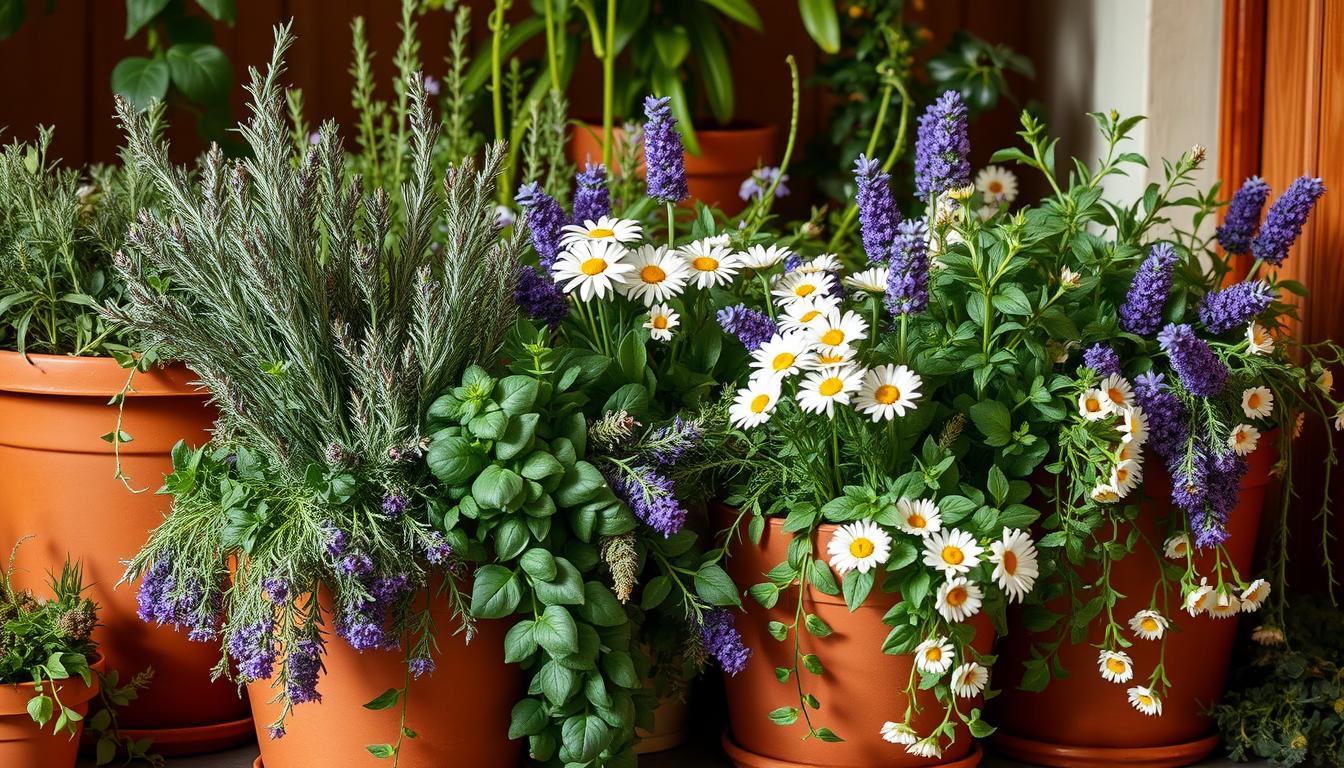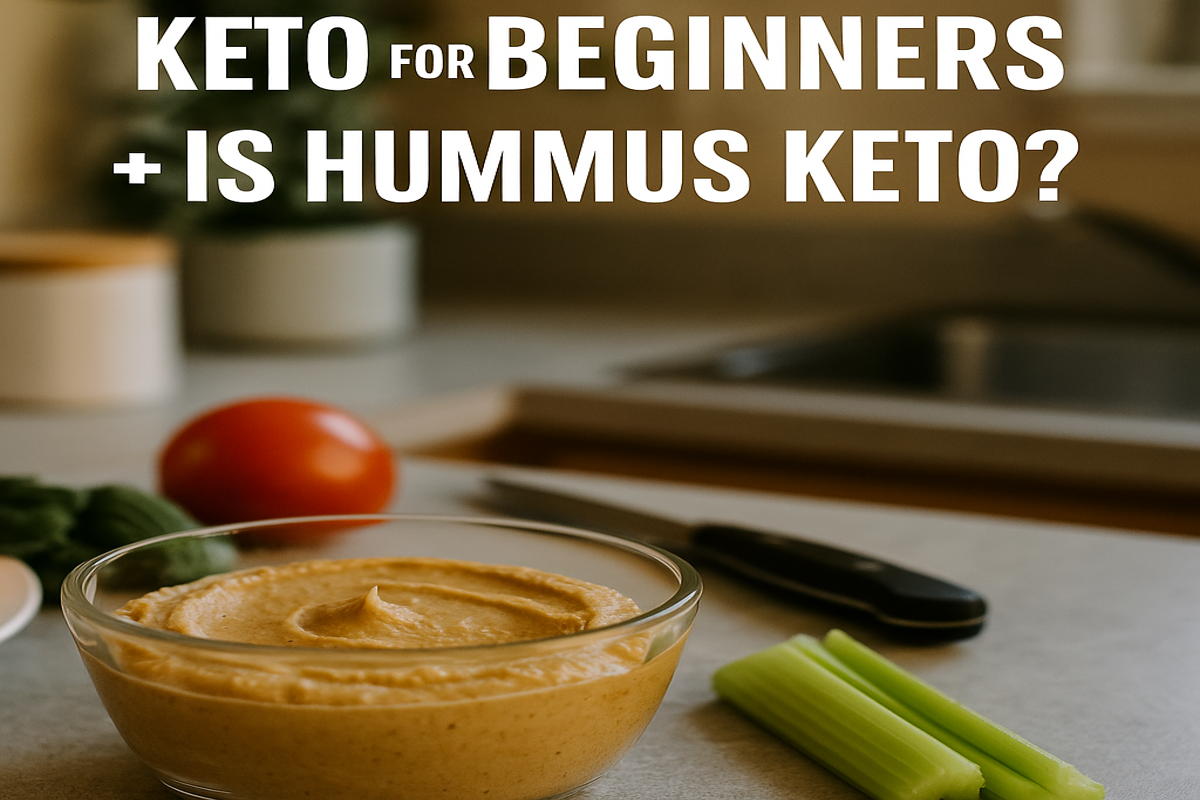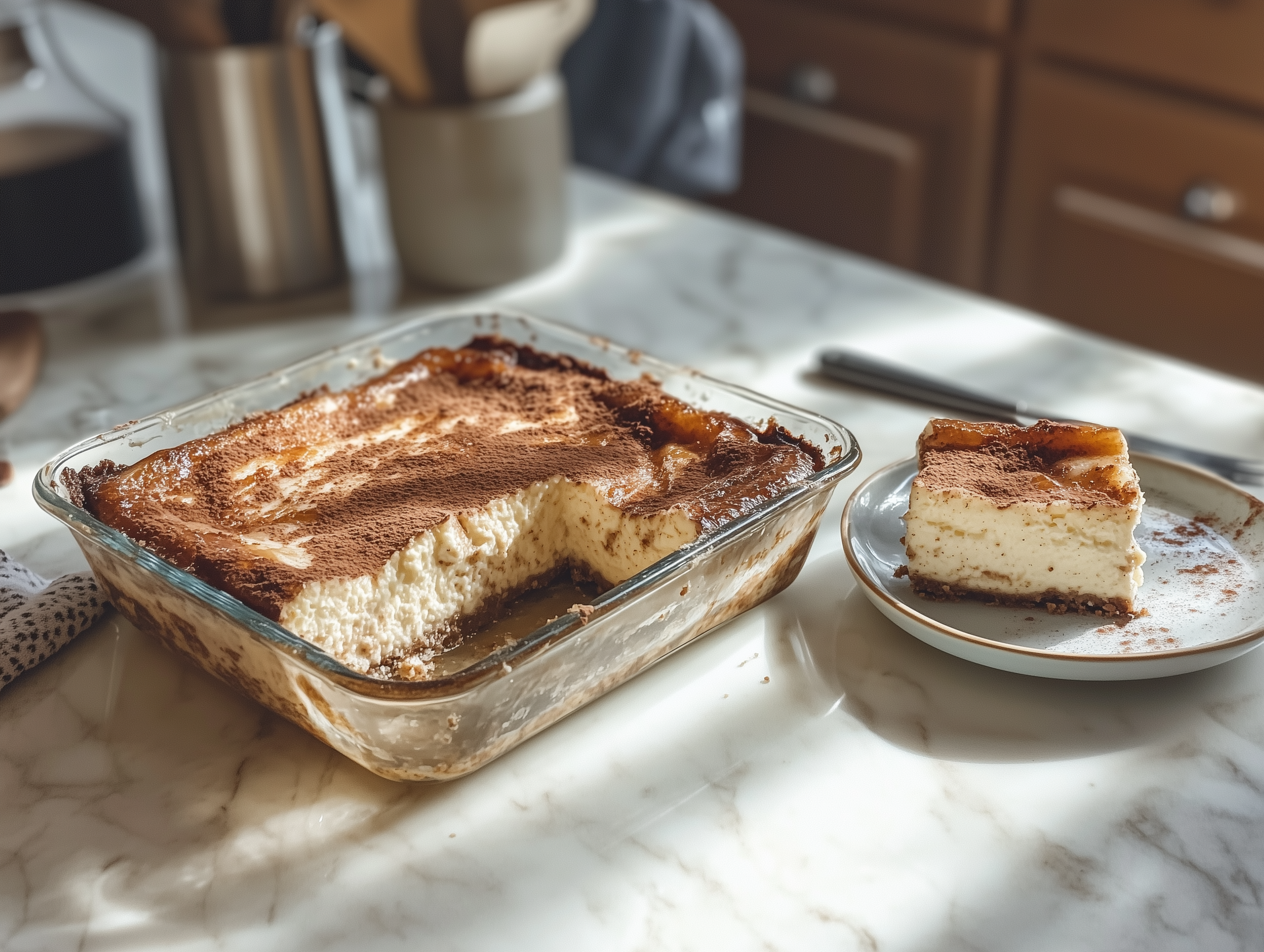Ever thought a small pot could turn into a lively garden? Planting herbs and flowers together in pots does more than look good. It turns your balcony or patio into a mini garden paradise.
Herb and flower mixes are more than pretty. They’re a smart way to use small spaces. They help control pests and attract pollinators, making them tiny but mighty gardens.
After years of gardening, I found the key to success. It’s about knowing which plants go well together. Each pot becomes a mini world that gives you tasty herbs and beautiful flowers.
Key Takeaways
- Companion planting creates multi-functional garden spaces
- Herbs and flowers can mutually benefit each other’s growth
- Container gardens maximize limited gardening areas
- Strategic plant combinations can naturally manage pests
- Herb and flower combinations offer both aesthetic and practical advantages
Benefits of Planting Herbs and Flowers Together
Pot gardening lets you grow herbs and flowers in creative ways. It turns a simple garden into a lively, useful space.
Planting herbs and flowers together has many benefits. They make your garden look great and serve many uses.
Enhancing Aesthetic Appeal
Container gardens are like art, mixing herbs and flowers. They offer:
- Stunning color contrasts
- Varied textures and heights
- Delightful fragrance combinations
- Dynamic visual interest
Maximizing Space
Pot gardening helps use small spaces well. By pairing herbs and flowers smartly, you can:
- Increase plant density
- Optimize vertical growing
- Create multi-functional spaces
- Reduce garden size
Encouraging Biodiversity
Container gardens support a healthy ecosystem. Certain herb and flower combinations attract good bugs, keep pests away, and help plants stay healthy.
Nature thrives when plants work together, and your container garden can become a miniature ecosystem of mutual support.
Best Herbs to Grow in Containers
Growing herbs in containers is a great way to garden. It lets you mix herbs and flowers well. You need to know what each plant likes and how it grows. Here are some popular herbs that do well in containers.

Container gardening is perfect for growing fresh herbs at home. Most herbs need 4-6 hours of sunlight and well-draining soil to grow well.
Basil: The Culinary Favorite
Basil is a top pick for container gardens. It loves warm weather and needs a lot of water. Choose a pot with good drainage and put it in a sunny spot. Companion planting can help basil grow well with certain flowers.
Chives: Versatile and Hardy
Chives are easy to grow and can handle partial shade. They’re great for areas with little sunlight. These herbs can even grow in cold zones, making them versatile for many climates.
Mint: The Container Champion
Mint grows fast and can take over. It’s best to grow it in its own pot. Choosing the right container is key for mint’s success.
- Choose containers at least 12 inches wide
- Ensure proper drainage holes
- Use high-quality potting mix
- Water consistently but avoid overwatering
Pro tip: Daily monitoring helps maintain healthy herb containers and promotes robust growth.
Popular Flowers to Pair with Herbs
Creating mixed herb and flower pots can make your garden lively and useful. Companion planting in pots adds beauty and helps gardeners get the most from their container gardens.
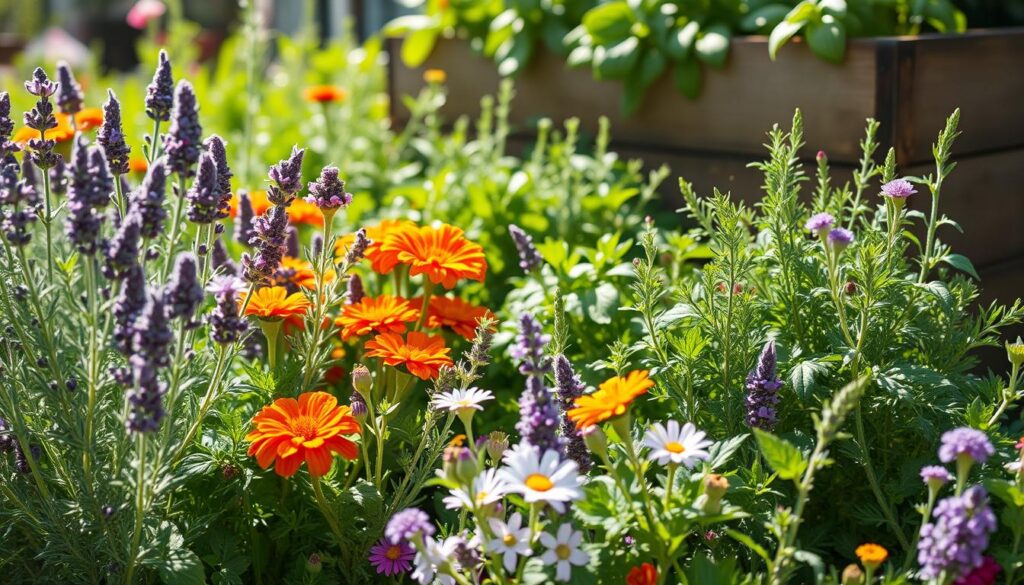
Marigolds: The Pest-Fighting Flower
Marigolds are true heroes in the garden. They’re not just pretty; they also protect your herbs. Here’s how:
- Repelling harmful nematodes
- Deterring aphids and beetles
- Attracting beneficial insects like ladybugs
Marigolds help keep your herb and flower pots pest-free. This makes your garden healthy and full of life.
Petunias: Colorful Herb Companions
Petunias add color and benefits to herb containers. They look great with herbs like basil, making your garden both beautiful and useful. Their long stems are great for hanging pots.
Pro tip: Choose petunia varieties that match your herbs’ sunlight and water needs for the best growth.
By mixing herbs and flowers, you’ll get a garden that’s both stunning and productive. It’s a win-win for your garden.
Key Considerations for Combining Plants
Creating a successful herb and flower container garden needs careful planning. It’s important to know each plant’s needs for a thriving garden. This ensures a healthy ecosystem.

Harmonious container gardens come from matching plants with similar needs. Not all herbs and flowers can live well together in one pot.
Light Requirements
Plants have different light needs. Here are some key points:
- Full sun herbs like basil and rosemary need 6-8 hours of direct sunlight
- Partial shade plants such as mint require less intense light
- Match plants with similar light tolerance to ensure healthy growth
Watering Needs
Watering is critical for your container garden. Plants should have similar moisture needs:
- Drought-tolerant herbs like thyme and sage
- Water-loving plants such as basil and parsley
- Avoid combining plants with drastically different hydration needs
Growth Rates
Knowing how plants grow helps avoid overcrowding. Here are some tips:
- Pair slow-growing herbs with similar flowers
- Avoid combining aggressive spreaders like mint with delicate plants
- Consider mature plant sizes when designing your container
By choosing the right herbs and flowers, you’ll have a beautiful, productive container garden. It will thrive in harmony.
15 Winning Combinations for Pots
Creating a vibrant container garden is easy with the right herb and flower pairings. By choosing the right plants, your planters can look great and be useful too.

Container gardening lets you try out many plant combinations. Here are some of my top picks for herb and flower pairings.
Basil and Petunias: A Colorful Duo
The mix of Ocimum basilicum and petunias is a winner. Basil’s green leaves match the petunias’ bright colors, making a beautiful sight. This combo is perfect for sunny spots and adds both flavor and beauty.
Learn more about pairing plantsfor your garden
Chives and Marigolds: Natural Pest Defenders
Chives and marigolds are great for keeping pests away. Their flowers, one purple and the other yellow, look good together. Plus, they keep insects from bothering your garden.
- Chives provide vertical interest
- Marigolds offer pest-repelling properties
- Both plants thrive in similar growing conditions
Mint and Nasturtiums: A Playful Combination
Mint and nasturtiums are a fun pair. Mint’s spreading habit and nasturtiums’ bright flowers make a lovely mix. They also give you tasty flowers and herbs for cooking.
Thyme and Zinnias: Texture and Color
Creeping thyme makes a great ground cover, and zinnias add height and color. This combo shows how different textures can make a container garden pop.
“The art of container gardening lies in creating harmonious plant relationships that are both beautiful and functional.” – Garden Design Expert
Easy-to-Care-For Combinations
Pot gardening doesn’t have to be hard. Many herb and flower mixes can grow well with little care. They’re great for those who are busy or new to gardening in pots.
Low-Maintenance Options
Choose plants for your container garden that are easy to care for. Some top picks include:
- Lavender – A drought-tolerant herb with beautiful purple flowers
- Rosemary – A hardy herb that thrives in minimal water conditions
- Thyme – A compact herb that grows well in small spaces
- Marigolds – Colorful flowers that are incredibly easy to grow
Drought-Resistant Pairings
For gardeners in hot or dry areas, these pairings are perfect:
- Lavender with Zinnia – Both love full sun and need little water
- Rosemary paired with Portulaca – Stunning drought-resistant companions
- Thyme alongside Sedum – Create a low-water, textured container garden
These plant mixes not only need less water but also look great. They make gardening in pots easy and fun.
Seasonal Planting Tips
Successful herb and flower container gardening needs careful planning for each season. Knowing which plants do well in certain weather can make your garden lively and fruitful.
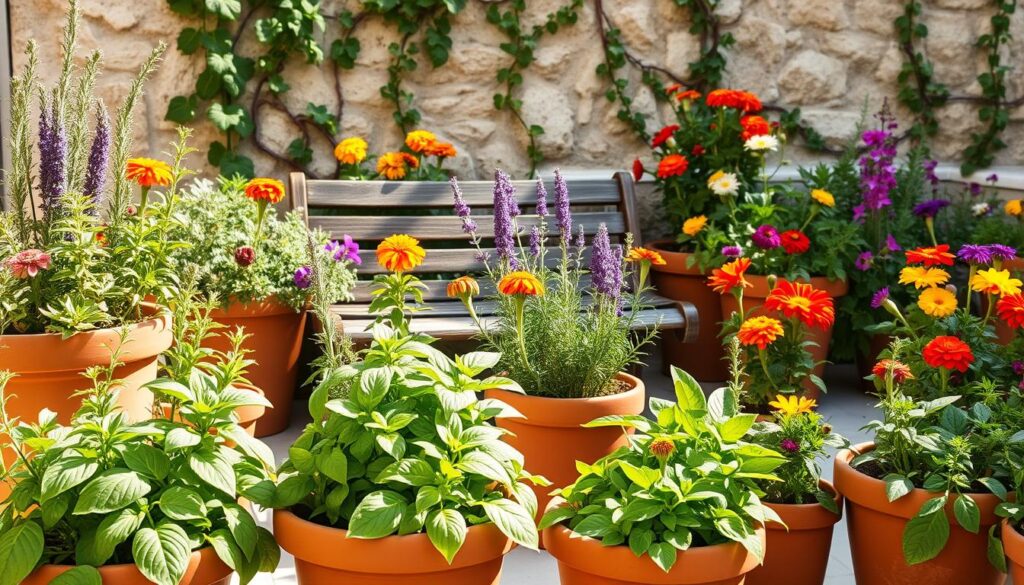
When planting herbs and flowers in containers, think about the season. Each season brings its own challenges and chances for gardeners.
Spring Pairings
Spring is a great time for herb and flower container gardening. Cold-tolerant herbs make beautiful and strong combinations during this time.
- Plant lavender with cool-weather pansies
- Combine parsley with spring snapdragons
- Pair rosemary with early-blooming calendula
Summer Enthuasists
Summer needs plants that love the heat and can handle lots of sunlight. Your garden can be a stunning mix of colorful herbs and flowers during these months.
- Grow basil alongside bright marigolds
- Plant thyme with drought-resistant petunias
- Create dynamic combinations of mint and zinnias
By choosing the right herbs and flowers for each season, you’ll have a lively and fruitful container garden all year.
Common Mistakes to Avoid

Creating successful herb and flower pairings needs careful planning. Many gardeners face challenges when mixing plants in containers. These issues can affect their growth and garden performance.
Overcrowding Challenges
One big mistake is overcrowding. Plants need room to grow and get nutrients. I’ve seen many gardeners make these common errors:
- Planting too many herbs and flowers in a single container
- Ignoring individual plant growth requirements
- Failing to consider mature plant sizes
Compatibility Considerations
Not all herbs and flowers get along. When pairing them, you must know each plant’s unique traits. Some key factors to consider include:
- Water requirements: Drought-tolerant herbs might struggle alongside plants needing frequent watering
- Nutrient needs: Some plants are heavy feeders and can deplete soil nutrients quickly
- Sunlight preferences: Mixing shade-loving and full-sun plants can lead to poor growth
By understanding these pitfalls, you can create thriving container gardens. These gardens will show the beauty and functionality of herbs and flowers together.
Maintaining Your Herb-Flower Pots
Keeping your herb and flower pots healthy needs regular care. A good plan is key for your plants to grow well. Here are some tips to help you take care of your container garden.

- Check your containers daily for water needs
- Monitor plant growth and health
- Implement regular pruning techniques
- Apply appropriate fertilization
Pruning Tips for Healthy Growth
Pruning is vital for your pots to look their best. Pinch back herbs often to keep them bushy. Use sharp scissors to cut off dead leaves and stems just above a leaf node.
Fertilization Guidelines
Fertilizing right is important for your pots. Pick a balanced, water-soluble fertilizer for herbs and flowers. Fertilize every 4-6 weeks in growing season, but don’t overdo it.
Here are some fertilization tips:
- Use organic compost for slow-release nutrients
- Dilute liquid fertilizers to half strength
- Apply fertilizer early in the morning
- Water plants before fertilizing
Pro tip: Always observe your plants’ response to pruning and fertilization, adjusting your approach as needed for optimal growth.
Pest Management for Combined Planters
Herb and flower container gardening needs good pest management to keep plants healthy. Planting herbs and flowers together in pots helps control pests naturally. It also makes your garden vibrant and full of life.
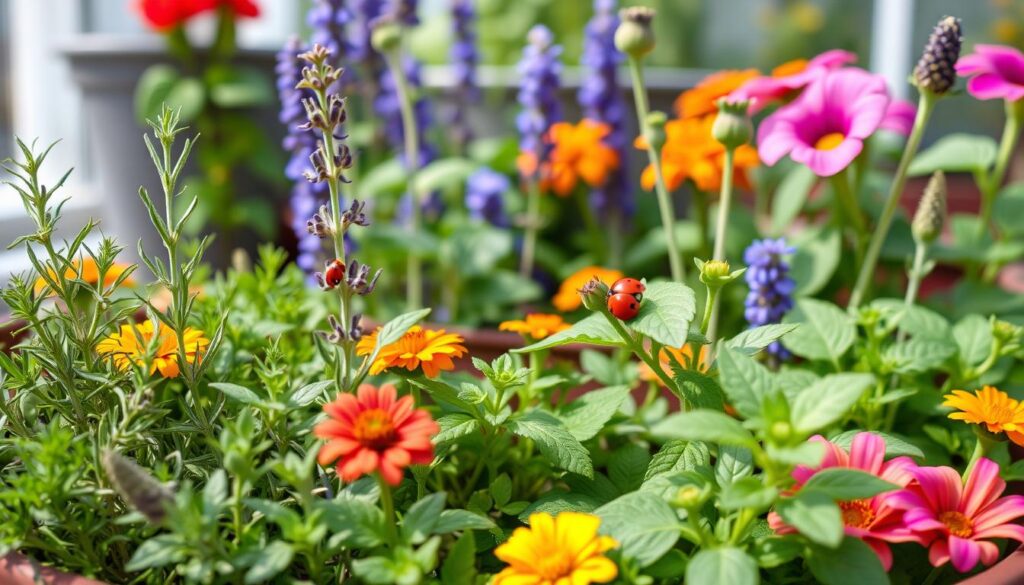
Companion planting is a key way to fight pests. Studies show that having more plant types can lower pest numbers. By picking the right herbs and flowers, you can protect your garden from pests.
Natural Pest Deterrent Strategies
Some herbs are great at keeping pests away. Here are my top picks:
- Mint – Repels many insects
- Basil – Keeps tomato hornworms away
- Thyme – Stops cabbage worms
- Dill – Draws good bugs
Companion Planting Techniques
Understanding how plants work together is key. Here are some good pairs:
- Nasturtiums trap aphids
- Marigolds attract good bugs
- Cilantro draws wasps
- Lemon verbena protects other plants
Using these methods in your garden can keep pests away naturally. You’ll also have a beautiful and productive garden.
Harvesting and Enjoying Your Blooms and Herbs
Harvest time is exciting after growing your herbs and flowers. Timing is key when picking herbs and flowers in containers. Most herbs taste best in the morning, when their oils are strongest.
Using your herbs and flowers in cooking is fun. Mix fresh basil with nasturtiums in salads or use thyme and zinnias as garnishes. Always cut herbs with sharp scissors just above a leaf node to help them grow.
There are ways to keep your garden’s flavors alive longer. Dry herbs like rosemary and sage to keep their taste for months. Freeze basil in olive oil to make flavor cubes for later. Knowing how to harvest each herb makes your garden a treasure trove of flavors.
Harvesting Techniques
Always take no more than one-third of the plant when you harvest. This helps your herbs keep growing and stay productive. Prune woody herbs like rosemary to keep them healthy and looking good.
Creative Culinary Uses
My favorite part is trying new recipes with fresh herbs. Make herb-infused oils, herbal teas, or use edible flowers as garnishes. With a thriving garden, the possibilities are endless.
Source Links
- https://plantperfect.com/herb-and-flower-container-combinations/ – Inspiring Herb and Flower Container Combinations | Bismarck, ND
- https://www.organicgardenco.com.au/blog/helpful-tips-for-your-garden/your-guide-to-companion-planting-herbs-combination/?srsltid=AfmBOor8TfZsacXsYkCNaNYNe1Ob1DH9_r8cJbZpaQGrtMgITV2MXqPV – Your Guide To Companion Planting Herbs & Combinations
- https://www.gardendesign.com/vegetables/companion-planting.html – Companion Planting Guide for Vegetables & Herbs – Garden Design
- https://www.sugarmaplefarmhouse.com/companion-planting-flowers-herbs-that-help-repel-bugs/ – Companion Planting : Flowers & Herbs that help repel bugs
- https://www.gardeningknowhow.com/edible/herbs/hgen/herb-plants-growing-in-one-pot.htm – Best Herbs To Plant Together In One Pot
- https://journeywithjill.net/gardening/2023/05/03/companion-planting-herbs-in-containers/ – Companion Planting Herbs in Containers | The Beginner’s Garden
- https://www.organicgardenco.com.au/blog/helpful-tips-for-your-garden/your-guide-to-companion-planting-herbs-combination/?srsltid=AfmBOop4YrFsOvl7lhh1-6BxMF04ApPmW8uiwgysHhP5JLhkMPZgdcgg – Your Guide To Companion Planting Herbs & Combinations
- https://www.bhg.com/gardening/landscaping-projects/landscape-basics/what-flowers-go-together/ – What Flowers Grow Well Together? Try These 28 Pretty Combinations
- https://www.gardenersworld.com/plants/10-companion-plants-to-grow/ – Companion planting: Best plants to grow together
- https://www.organicgardenco.com.au/blog/helpful-tips-for-your-garden/your-guide-to-companion-planting-herbs-combination/?srsltid=AfmBOopP727jtvlMrxiINv-dU4F8BUGJDM7U4zeRLoVIIqyTjMZDcZbj – Your Guide To Companion Planting Herbs & Combinations
- https://www.gardeningknowhow.com/edible/herbs/hgen/companion-planting-in-your-herb-garden.htm – What Herbs Can Be Planted Together? Best Combinations To Try
- https://www.epicgardening.com/container-arrangements/ – 25 Beautiful Plant Combination Ideas For Container Gardens
- https://hayefield.com/2015/01/15/better-together-herbs-part-1/ – Hayefield
- https://www.organicgardenco.com.au/blog/helpful-tips-for-your-garden/your-guide-to-companion-planting-herbs-combination/?srsltid=AfmBOopnCWqhJwoig6yK05LQHq3fySlCtptOU8Q06V1mgQN3Oxu1ixDY – Your Guide To Companion Planting Herbs & Combinations
- https://www.bhg.com/gardening/container/plans-ideas/plant-combinations-for-beautiful-container-gardens/ – 29 Flower Pot Ideas for Stunning Mixes of Blooms and Foliage
- https://www.almanac.com/companion-planting-guide-vegetables – Companion Planting Chart and Guide for Vegetable Gardens
- https://www.organicgardenco.com.au/blog/helpful-tips-for-your-garden/your-guide-to-companion-planting-herbs-combination/?srsltid=AfmBOoqNN8Ncuiwx5HZq5z5ThVyPVkiPmvrDG7JQqeLwdQeLDjyc5qGB – Your Guide To Companion Planting Herbs & Combinations
- https://www.epicgardening.com/companion-planting-mistakes/ – 15 Companion Planting Mistakes to Avoid This Season
- https://www.greenandprosperous.com/blog/companion-planting-how-to-do-it-mistakes-to-avoid – Companion planting: how to do it, mistakes to avoid — Green and Prosperous
- https://www.organicgardenco.com.au/blog/helpful-tips-for-your-garden/your-guide-to-companion-planting-herbs-combination/?srsltid=AfmBOorM12kgjhEwp6Hb-7qc7vM7BFEVS8INWv3Rh3B8WWALqJDXD62X – Your Guide To Companion Planting Herbs & Combinations
- https://www.homesandgardens.com/gardens/growing-herbs-in-pots – Growing herbs in pots – 10 expert tips for delicious edibles all year long
- https://www.marthastewart.com/8369699/herb-garden-ideas – 10 Indoor and Outdoor Herb Garden Ideas That Guarantee Fresh Basil, Parsley, and More All Year Round
- https://journeywithjill.net/gardening/2019/02/26/companion-planting-pest-control/ – Companion Planting for Pest Control | The Beginner’s Garden
- https://www.gardenersworld.com/plants/companion-planting-combinations/ – Companion planting combinations
- https://meadowlarkjournal.com/blog/what-herbs-can-be-planted-together – What Herbs Can Be Planted Together — Meadowlark Journal
- https://www.greenhousestudio.co/home-garden/how-plant-herb-container-garden – How to plant an herb container garden for patio or kitchen — Greenhouse Studio
